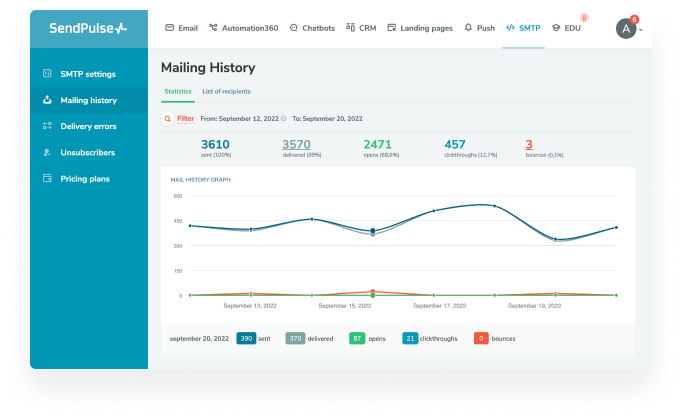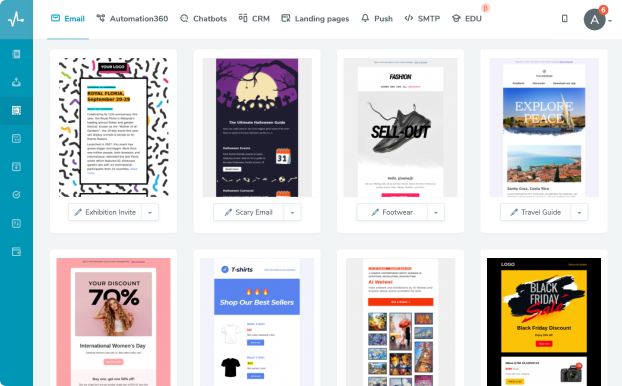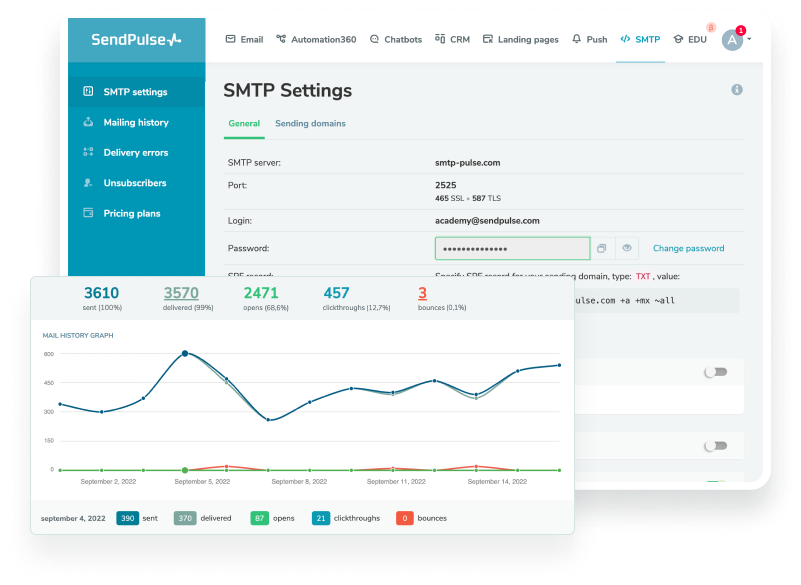Our customers love us

Easy setup using the SMTP protocol

Reliable servers and dedicated IP addresses

Flexible API for developers

24/7 live chat support
How to use SMTP for business
SMTP is the easiest way to start sending transactional email campaigns to confirm registration, provide order updates, or thank a client for a purchase



Send transactional emails
Integrate an SMTP server into your CMS, CRM, or website builder to send emails directly to your customers without additional configuration in the email service.
Your clients will receive messages instantly, even if you have thousands of orders daily.


Explore detailed reports in your account


Use free transactional email templates
How to use the SMTP service API for email campaigns
<?php
use Sendpulse\RestApi\ApiClient;
use Sendpulse\RestApi\Storage\FileStorage;
$smtpSendMailResult = (new ApiClient('MY_API_ID', 'MY_API_SECRET', new FileStorage()))->post('smtp/emails', [
'email' => [
'html' => base64_encode('<p>Hello!</p>'),
'text' => 'text',
'subject' => 'Mail subject',
'from' => ['name' => 'API package test', 'email' => 'from@test.com'],
'to' => [['name' => 'to', 'email' => 'to@test.com']],
'attachments_binary' => [
'attach_image.jpg' => base64_encode(file_get_contents('../storage/attach_image.jpg'))
]
]]);
var_dump($smtpSendMailResult);
?>
sample.php hosted with ❤ by
github.com/sendpulse/sendpulse-rest-api-php
# SendPulse's Ruby Library: https://github.com/sendpulse/sendpulse-rest-api-ruby
require './api/sendpulse_api'
sendpulse_api = SendpulseApi.new(API_CLIENT_ID, API_CLIENT_SECRET, API_PROTOCOL, API_TOKEN)
email = {
html: '<p>Your email content goes here<p>',
text: 'Your email text version goes here',
subject: 'Testing SendPulse API',
from: { name: 'Your Sender Name', email: 'your-sender-email@gmail.com' },
to: [
{
name: "Subscriber's name",
email: 'subscriber@gmail.com'
}
]
}
sendpulse_api.smtp_send_mail(email)
sample.rb hosted with ❤ by
github.com/sendpulse/sendpulse-rest-api-ruby
# SendPulse's Python Library: https://github.com/sendpulse/sendpulse-rest-api-python
from pysendpulse import PySendPulse
if __name__ == "__main__":
TOKEN_STORAGE = 'memcached'
SPApiProxy = PySendPulse(REST_API_ID, REST_API_SECRET, TOKEN_STORAGE)
email = {
'subject': 'This is the test task from REST API',
'html': '<p>This is a test task from https://sendpulse.com/api REST API!<p>',
'text': 'This is a test task from https://sendpulse.com/api REST API!',
'from': {'name': 'John Doe', 'email': 'john.doe@example.com'},
'to': [
{'name': 'Jane Roe', 'email': 'jane.roe@example.com'}
]
}
SPApiProxy.smtp_send_mail(email)
sample.py hosted with ❤ by
github.com/sendpulse/sendpulse-rest-api-python
// SendPulse's Java Library https://github.com/sendpulse/sendpulse-rest-api-java
import com.sendpulse.restapi.Sendpulse;
import java.util.ArrayList;
import java.util.HashMap;
import java.util.Map;
public class Example {
public static void main(String[] args) {
Sendpulse sendpulse = new Sendpulse(API_CLIENT_ID, API_CLIENT_SECRET);
Map<String, Object> from = new HashMap<String, Object>();
from.put("name", "Your Sender Name");
from.put("email", "your-sender-email@gmail.com");
ArrayList<Map> to = new ArrayList<Map>();
Map<String, Object> elementto = new HashMap<String, Object>();
elementto.put("name", "Subscriber's name");
elementto.put("email", "subscriber@gmail.com");
to.add(elementto);
Map<String, Object> emaildata = new HashMap<String, Object>();
emaildata.put("html","Your email content goes here");
emaildata.put("text","Your email text version goes here");
emaildata.put("subject","Testing SendPulse API");
emaildata.put("from",from);
emaildata.put("to",to);
Map<String, Object> result = (Map<String, Object>) sendpulse.smtpSendMail(emaildata);
System.out.println("Result: " + result);
}
}
sample.java hosted with ❤ by
github.com/sendpulse/sendpulse-rest-api-java
// SendPulse's Node.JS Library: https://github.com/sendpulse/sendpulse-rest-api-node.js
var sendpulse = require("./api/sendpulse.js");
sendpulse.init(API_USER_ID, API_SECRET, TOKEN_STORAGE);
var email = {
"html" : "<p>Your email content goes here</p>",
"text" : "Your email text version goes here",
"subject" : "Testing SendPulse API",
"from" : {
"name" : "Your Sender Name",
"email" : "your-sender-email@gmail.com"
},
"to" : [ {
"name" : "Subscriber's name",
"email" : "subscriber@gmail.com"
} ]
};
var answerGetter = function answerGetter(data){
console.log(data);
}
sendpulse.smtpSendMail(answerGetter, email);
sample.js hosted with ❤ by
github.com/sendpulse/sendpulse-rest-api-//www.spcdn.org/node.js
#import "Sendpulse.h" // SendPulse's Obj-C Library https://github.com/sendpulse/sendpulse-rest-api-objective-c
- (void)viewDidLoad {
[super viewDidLoad];
[[NSNotificationCenter defaultCenter] addObserver:self selector:@selector(doSomethingWithTheData:) name:@"SendPulseNotification" object:nil];
Sendpulse* sendpulse = [[Sendpulse alloc] initWithUserIdandSecret:userId :secret];
NSDictionary *from = [NSDictionary dictionaryWithObjectsAndKeys:@"Your Sender Name", @"name", @"your-sender-email@gmail.com", @"email", nil];
NSMutableArray* to = [[NSMutableArray alloc] initWithObjects:[NSDictionary dictionaryWithObjectsAndKeys:@"Subscriber's name", @"name", @"subscriber@gmail.com", @"email", nil], nil];
NSMutableDictionary *emaildata = [NSMutableDictionary dictionaryWithObjectsAndKeys:@"<b>Your email content goes here</b>", @"html", @"Your email text version goes here", @"text",@"Testing SendPulse API",@"subject",from,@"from",to,@"to", nil];
[sendpulse smtpSendMail:emaildata];
}
- (void)doSomethingWithTheData:(NSNotification *)notification {
NSMutableDictionary * result = [[notification userInfo] objectForKey:@"SendPulseData"];
NSLog(@"Result: %@", result);
}
sample.m hosted with ❤ by
github.com/sendpulse/sendpulse-rest-api-objective-cSMTP service features
Dedicated IP addresses
We monitor the reputation of all IP addresses to ensure maximum deliverability.
DKIM and SPF signatures
Authenticate your company's sender domain with the help of special cryptographic signatures.
Servers you can trust
Send email campaigns via European data centers with SSL connection support.
Enhance your communication with customers by sending transactional emails via SMTP or API
You can read our detailed API documentation and find all the necessary settings for the SMTP server in your account
Try for freeNo credit card required
We will help you get the hang of the SendPulse services
We strive to make our SMTP service as intuitive and user-friendly as possible.
If you have any questions, you can contact our customer support or refer to our free resources.
Start a chat or fill out the form — we are here for you 24/7 and can assist our users in five languages.
Learn more about the limits on sending speed, traffic, and the number of used domains and IP addresses.
Don't have enough time to explore SendPulse's functionality by yourself?
Enhance your communication with customers
FAQ
What is an SMTP server?
The Simple Mail Transfer Protocol is a method of exchanging information between a sender’s and a recipient’s servers. You can use the SendPulse SMTP server to send HTML emails without trying our other services and features.
Why should I use an SMTP server?
An SMTP server allows you to send all sorts of transactional emails, e.g., confirmation emails, abandoned cart emails, shipping updates, notifications, etc. SendPulse’s SMTP server is reliable and has a high deliverability rate and sender reputation.
How can I set up an SMTP server?
You need to register with SendPulse, fill in a simple form, and set up your authentication parameters. Follow the prompts, and remember that our customer support team is always here to help.
How much does it cost to use an SMTP server?
With SendPulse, you can send up to 12,000 emails for free each month. If you want to send more emails via our SMTP server, you need to choose between our monthly subscription plans and pay-as-you go plans. Learn more about our SMTP server pricing here.
Integrate email campaigns into your project right now
Send transactional emails instantly via SMTP or API with exceptional deliverability
Try it now12,000 emails per month for free













or